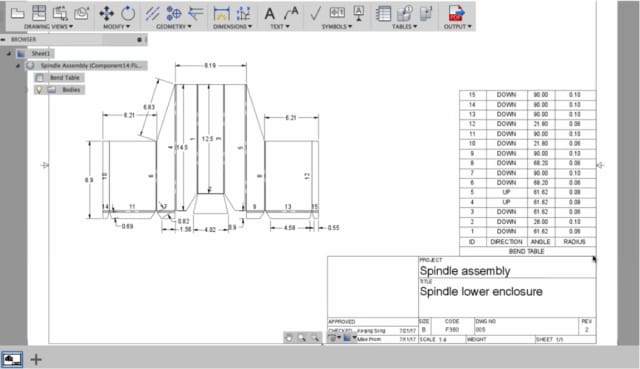

Once sheet metal is released, we will be focused on providing a solution to the following workflows:

At this time, sheet metal will be taken out of preview and available for all. Our target for the public release of sheet metal is July 24th.

Notice that you also have the ability to show or hide bend extents by checking/unchecking the option in the Drawing View dialog.Īssociative bend tables and bend datums, and bend notes are not available yet, but they are currently in development and will be available in a future update. Once it gets transported to the 2D drawings workspace, you’ll have all the existing 2D drawings tools at your disposal. Notice that the representation is now a flat pattern. Once you’ve got it, hop over to the drawings workspace and create a drawing from the design. First, create a flat pattern of your sheet metal part by going to the modify drop-down menu and select “Create flat pattern”. Sheet metal flat pattern and bend lines for 2D drawings are also comingįor those of you who are part of the preview, you’ll be happy to know that you can now create 2D drawings of your sheet metal flat patterns. The included rules library has also been updated to take advantage of this. if your bend relief depth should be half of the material thickness, you can type “Thickness / 2” as your Relief Depth value, and this will calculate the value using the rule’s thickness). Values can now be defined as parametric functions of the sheet metal thickness, by referring to “Thickness” in the expression (e.g. However, these values were previously all hard-coded, meaning that changing the thickness of the material required all of the other values to be updated manually. In standard sheet metal rules, most dimensions are multiples or fractions of the material thickness. We have also improved sheet metal rule values defined as functions of thickness So what’s the difference between flat pattern and unfold? Flat pattern now lets you edit your bend thickness and K factor, whereas if you just did an unfold without the flat pattern tool, those values were not editable. Notice that if you already have a flat pattern, Fusion 360 will ask if you want to activate the existing one.Ī flat pattern is modal, so once it’s created, you’ll have to “Exit Flat” to get back to the bent model. Once it’s active, select the face you want as stationary, and it’ll flatten your part. You will be able to create flat patterns of your sheet metal designs! Access it under the modify drop-down menu in your sheet metal preview workspace. In our upcoming May update “drum roll”, we’ll be adding flat patterns !!! The work on this will start after our first release. Due to the insights of our users, we are going to enhance these tools to follow the sheet metal rules. I didn’t take into account how much our press/pull and move tools are loved and/ or used. What else we learned – Beyond the improvements to flange and rules, one big discovery was around workflows. In July, there will be enhancements around the dialog dropbox and soon after our initial release in context options. However, one thing we missed was flange width discoverability. Based off of feedback, we changed to a default library where users can edit and customize to fit their needs.įor flange, there has been a lot of good feedback around the simplicity of the tool. There was also confusion around use and editing of samples rules. We learned that this complicated things and changed it to a “new” button. In the beginning we had “duplicate rule” as a way to make a new rule based off of a current rule. What we learned and improved based off feedback – Editing and creating new materials was not discoverable. Not only is this faster for experienced sheet metal users, it is also easier for new ones. Rather than taking the extra time to pick features up, why not pick based off of selection? Our flange tool creates a base, contour, edge and join flange.

While planning, we kept coming back to one question. Our objective is to make it so easy to create and reuse a rule, that our users all have a custom library.ĭepending on the CAD package, there are any number of different “flange” sheet metal features. However, a majority of them don’t take the time to create rules that reflect the materials. The goal of the preview was to get feedback on sheet metal rules and flange, while the team finished work on flatten.īased off research and feedback, we have found that people who use sheet metal typically have 5-10 different materials. Back in January we released sheet metal in a limited preview for Fusion 360.


 0 kommentar(er)
0 kommentar(er)
